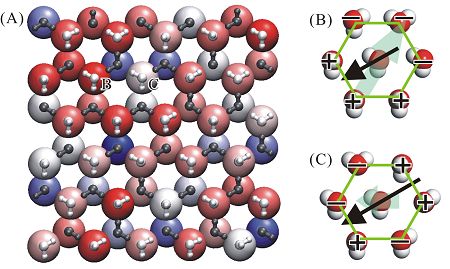Peking University, Sept.26, 2011: Nature Materials has recently reported the newest progress of the research on the molecular vacancy formation energy on the ice surface, which is conducted by Peking University (PKU) and University College London (UCL) researchers collaboratively. This is their most recent findings after the discovery of regular distribution of hydrogen atoms on ice surface [see Extended Reading 1]. They are the first to prove that molecular vacancy formation energy is widely distributed on ice surface, which contributes to the understanding of ice pre-melting and ice crystallization process.
The research breakthrough is a joint effort of Wang Enge, professor of PKU School of Physics and PKU International Center for Quantum Materials, Pan Ding, a Ph.D. candidate from Institute of Physics Chinese Academy of Sciences and researchers from UCL. And this research rpoject is partly supported by the Chinese National Natural Science Foundation.
Ice is one of the most abundant and important materials on the earth, which has a great bearing on mankind or even the whole biosphere. However, the property of ice surface has always been an endlessly question debated in the academic world. The project team under Wang Enge proved that molecular vacancy formation energy is widely distributed on ice surface. For example, on the same ice surface, the vacancy formation energy of some molecules can be only 1/3 that of the others, only about 0.1-0.2 eV. The range of vacancy formation energy on ideal ice crystal surface even equals to that of amorphous ice. This shows that number of vacancies on ice surface is much more than the previous estimate, which made ice particles reactive more in physical and chemical reactions than the previous estimate. The fundamental reason of the abnormal phenomenon is the local electric field caused by effective charge on ice surface, which directly influences the electric dipole moment of surface layer of water molecule and further provide different vacancy formation energy for different situations. This research achievement proves abnormal phenomenon on the surface of ice crystal as one typical geometrical frustrated material. The series of these researches forecast that there may be completely unknown physical and chemical properties on the surface of other frustrated materials like spin ice [ see Extended Reading 2 ].

This picture shows the spatial distribution of dipole moment of water molecule on ice surface. (A) is the top view of ice(0001) surface. The colors of balls represent sizes of dipole moment, which turns small to big from red to blue. (B) & (C) are two examples of (A), which shows how the local electric field (the light blue arrow in the picture) affects the dipole moment of water molecule (the black arrow in the picture).
Extended Readings:
[1] Ding Pan, Li-Min Liu, Gareth A. Tribello, Ben Slater, Angelos Michaelides, and Enge Wang, Phys. Rev. Lett. 101, 155703 (2008).
[2] M. Watkins, D. Pan, Enge Wang, A. Michaelides, J. VandeVondele and B. Slater, NATURE Material (online 10.1038/NMAT3096, 04 September 2011).
Written by: Zhang Hao
Edited by: Li Xiaomeng
Source: PKU News (Chinese)